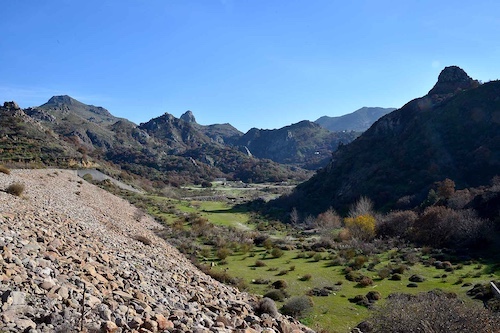(Mountains at Eresos)
Finally the weather Gods released wet clouds above Lesvos. They took days to decide whether or not to release buckets full of rain, but in the end, they chose a softer approach. So, the plants were not satisfied immediately but at least this way didn’t cause a Valencia situation. There was however enough water to coax the snails out of their dark holes to perform a snails’ pace dance, before hungry Greeks snatched them up in order to make a spicy dish.
And then there were the clouds skimming across the island, unveiling now and then the sun, and curling themselves around the top of volcanic mountains, so that for a moment you could imagine how these mountains might have looked when they were rumbling and grumbling and spitting fire.
But that happened millions of years ago, when Hephaistus, God of stonemasonry and blacksmiths, hunched over piping hot flames for days on end, using the volcanoes as his forge. Spitting calderas formed the landscape of Lesvos with curling layers of stone and basalt pillars; they sprinkled enormous rocks over the landscape and hid their tracks under layers of fertile lava in the north and west of the island. The calderas can be found at Stipsi, Skalochori, Anemotia, Vatoussa, Mesotopos, Agra and Sigri.
The Lesvorian volcanoes do not belong to the Big Five Greek volcanoes that are occasionally live: on Kos, Nisyros, Milos, Methana and on the most known volcanic island Santorini. These fire spitting mountains belong to the South Aegean Volcano Arc, a youngest generation of volcanoes, no older than two millions of years old. The volcanoes of Lesvos belong to the Volcanic Centers in the North Aegean, that were active some twenty millions of years ago, but have stopped entirely their activity.
Santorini with its white houses on the border of the crater has a dramatic beauty, that gets trampled by too many tourists. Lesvos does not (yet) have this problem, even though the land in the north and the west is just as beautiful, having been shaped by all that fire and lava (such as the magnificent rough landscape with its razor sharp mountain peaks around Eresos).
Moreover the Lesvorian volcanoes, together with the weather gods, created masses of petrified trees, a rare phenomenon in the world. In Sigri, where sunsets are as captivating as in Santorini, is the museum* that explains all about the volcanoes of Lesvos, the petrified trees, the earthquakes and the geological factors that had a say in the turbulent forming of the island.
The ground under Lesvos still boils and bubbles. It is known that volcanic areas regularly get disturbed by earthquakes, moments where the earth crusts fight each other. Because of all this turmoil the earth crust on some places on the island is so thin that hot springs have appeared. The island has more than one place where spas offer baths in this hot water, rich with minerals. Some bath houses are modernized, like those of Thermi and Polichnitos, some are in decay, like the ones in Eftalou and Lisvori.
Because on the island the heat reservoirs pushing the hot water upwards lie close to the earth’s surface, they also form an excellent opportunity to harness geothermal energy. That is an energy that is released thanks to the difference in temperatures of the earth’s surface and the subterranean heat reservoirs. In Polichnitos plans are ready for a geothermal station, that can provide energy for residential needs and local agricultural businesses. Now too, around Molyvos and Petra the activities of the local geothermal field have recently been researched. The geothermal field of Stipsi, as it is called, could provide electricity for 25% of the island. The station would be built in Stipsi.
Now that we are used to the ‘zoof-zoof’ sound of the plots of huge windmills; a group of energy makers are changing their interest to geothermal energy and they also want to develop a battery energy storage system in order to reduce wind power. That might mean that the old plans to crown the tops of volcano mountains with huge windmills might be off the table. Because even though the volcanoes of Lesvos have been lulled into an eternal sleep, the island still has plenty of energy under its feet.
* Natural History Museum of the Lesvos Petrified Forest











